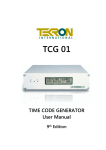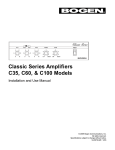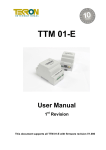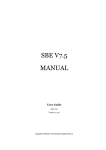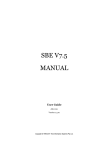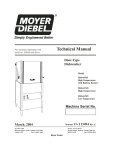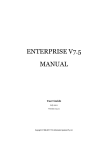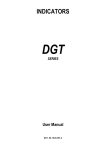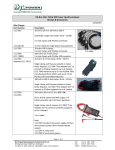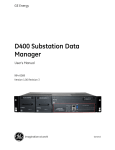Download TCG 01 User Manual
Transcript
TCG 01 TIME CODE GENERATOR User Manual 9th Edition www.tekroninternational.com Page 2 of 49 TCG-01 Time Code Generator User Manual 9th Edition February 2007 This document supports all TCG-01 with firmware revision D1—D8 Revision History: R4 R5 R6 R7 R8 R9 For 0, A-B TCG-01 For 0, A-B and C4-C7 TCG-01 All C and D up to D1 version TCG-01 All C and D up to D1 version TCG-01 All C and D up to D4 version TCG-01 (This document) For D up to and including D8 version TCG-01 www.tekroninternational.com TABLE OF CONTENTS 1 INTRODUCTION....................................................................................................1 2 INSTALLATION ...................................................................................................... 2 2.1 Packing list..................................................................................................................................... 2 2.2 Mounting ....................................................................................................................................... 2 3 OPERATION ............................................................................................................3 4 FRONT PANEL........................................................................................................3 4.1 LCD Display ................................................................................................................................... 4 4.2 Front Panel LED Indicators: ...................................................................................................... 6 5 CONNECTIONS...................................................................................................... 7 5.1 P1: Power Input .......................................................................................................................... 7 5.2 5.3 5.4 5.5 5.6 5.7 5.8 Ant: Antenna connector (SMA plug)..................................................................................... 7 P2, P3: Outputs............................................................................................................................. 8 P4: RS232 I/O (Serial port plus programmable output) ................................................ 9 Earth stud.....................................................................................................................................10 P5: BNC output .........................................................................................................................10 P6: Event Recording Inputs or External Sync Input........................................................ 11 P7: Sync Relay .............................................................................................................................11 5.9 P8: NTS – network time-server (optional).........................................................................12 6 SPECIFICATIONS .................................................................................................13 6.1 6.2 6.3 6.4 Dimensions .................................................................................................................................. 13 Identification............................................................................................................................... 13 Programmable outputs (P2, P3, P4-pin1) .........................................................................13 Isolation & Protection .............................................................................................................. 14 7 FACTORY HARDWARE OPTIONS...................................................................15 7.1 TCG 01 High Voltage Output Option .................................................................................15 7.2 Power Supply Options .............................................................................................................16 7.3 Lightning Protection Option .................................................................................................16 7.4 Multi-port Hub Option............................................................................................................ 16 8 TCG 01 CONFIGURATION SOFTWARE.........................................................17 8.1 8.2 8.3 8.4 8.5 Introduction ................................................................................................................................ 17 Local Time Settings................................................................................................................... 18 General Options .........................................................................................................................18 Programmable Outputs........................................................................................................... 20 IRIG-B Options ........................................................................................................................... 22 TCG 01 User Manual th 9 Edition: February 2007 8.6 Local/UTC Selection ................................................................................................................. 22 8.7 Network Time Server Configuration................................................................................... 23 8.8 Visible Satellites......................................................................................................................... 23 APPENDIX A ANTENNA DETAILS ........................................................................25 A.1 Antenna Cable Specification ................................................................................................. 25 A.2 Antenna Specification ............................................................................................................. 26 A.3 Antenna Assembly .................................................................................................................... 26 APPENDIX B LIGHTNING PROTECTION OPTION ...........................................28 B.1 General ......................................................................................................................................... 28 B.2 LPK01 Kit Contents................................................................................................................... 28 B.3 Installation................................................................................................................................... 29 B.4 Disclaimer .................................................................................................................................... 31 APPENDIX C EVENT TIME-TAGGING OPTION ................................................32 C.1 Introduction................................................................................................................................ 32 C.2 TCG 01 Command / Response Message structure ......................................................... 33 C.3 TCG 01 Commands related to Event Time Tagging ...................................................... 33 APPENDIX D NETWORK TIME SERVER OPTION .............................................36 D.1 Configuration Requirements................................................................................................. 36 D.2 Methods for Accessing Set-Up Mode ................................................................................ 36 D.3 Using Telnet to access Set-Up Mode.................................................................................. 37 D.4 NTS Set-Up Mode Menu ........................................................................................................ 38 D.5 Time Server Operation ............................................................................................................ 40 APPENDIX E SERIAL OUTPUT STRINGS.............................................................42 E.1 E.2 E.3 NGTS Time Code O/P on P4.................................................................................................. 42 IRIG J-17 Time Code O/P on P4 ........................................................................................... 42 String-A Time Code O/P on P4 ............................................................................................ 43 E.4 E.5 E.6 E.7 E.8 E.9 E.10 String-B Time Code O/P on P4............................................................................................. 43 String-C Time Code O/P on P4............................................................................................. 44 String-D Time Code O/P on P4 ............................................................................................ 44 String-E Time Code O/P on P4 ............................................................................................. 45 String-F Time Code O/P on P4 ............................................................................................. 45 NMEA ZDA Time Code O/P on P4....................................................................................... 46 NMEA RMC Time Code O/P on P4...................................................................................... 47 WARRANTY STATEMENT..........................................................................................48 TCG 01 User Manual th 9 Edition: February 2007 1 INTRODUCTION TCG 01 Time Code Generators produce precision time code signals, serial strings and pulses for use in synchronising industrial control and SCADA equipment. They are ideally suited to providing time synchronisation simultaneously to many different devices, such as Remote telemetry Units (RTUs), Protection Relays and other Intelligent Electronic Devices (IEDs) used in electrical sub-stations and industrial control installations. The TCG 01 features one AM Modulated IRIG-B output, three programmable outputs and a serial port which is user-configurable to output serial strings and report events for units fitted with event recording capability. Factory options include an embedded Network Time Server, and a choice of output connectors: BNC, 2-pin plug, or ST Fibre. Non-fibre outputs that can be ordered are TTL, RS422, or high voltage switching. All TCG 01 units feature a front panel display, giving visual feedback about the time data being generated on the outputs. LED indicators provide “at a glance” status information. Figure 1 – TCG-01 Front Panel The optimised receiver/antenna system used by TCG 01 obtains time with similar to atomic clock precision from the GPS satellite constellation. The result is output timing accuracy similar to that normally seen only in laboratory instruments. However, unlike laboratory instruments, TCG 01 is suited for hostile electromagnetic environments such as sub-stations and electrical switchyards. Each output of the TCG 01 is isolated from every other output, so that attached wiring can feed out to operating areas in different earth potential zones without compromising the overall site earthing security. Further isolation protects the internal electronics, and transient suppression devices protect i/o from both longitudinal and transverse high voltage events. TCG-01 occupies less than half the width of a 1U rack space. It is supplied complete with all hardware and software required for installation, including rack-mount kit, connectors, 30m lead-in antenna cable, and antenna. Page 1 of 49 www.tekroninternational.com 2 INSTALLATION 2.1 Packing list Each TCG 01 kit is shipped with the following: 2.2 TCG 01 Time code generator User Manual – this document GPS Antenna optimised for stationary applications, with pedestal for pipe mount Antenna lead-in cable fitted with matching connectors 19” Rack mounting Plate & fasteners Matching plug-in connectors RS232 Interface cable Configuration Software Mounting The clock is designed to be mounted in a 19” rack, but may be used on a bench. The unit is attached to the rack mount plate via the four screws shipped installed in the four corners of the front panel. GPS Antenna: Detailed antenna mounting instructions are contained in Appendix A on page 25. The antenna should be located in a position with as clear a view of the sky as possible, over as wide an angle as possible. The antenna should also be mounted in a “lightning-protected zone” as far as is possible. In practice, this means ensuring that there is at least one other earth-bonded structure located in the same rooftop area (e.g. another antenna, or a lightning rod) that reaches significantly higher than the top of the GPS antenna. The GPS Antenna should be mounted so that it lies within a 45-degree angle “skirt” from the top of the other earth-bonded structure. The GPS antenna mount itself should also be securely bonded directly to the building protection earth – and not connected via any of the other earthed structures. A lightning protection kit is available for installation in the antenna lead-in cable for additional protection of the equipment. (See section 7.3 on page 16 for details.) All TCG 01 antenna installations should follow the guidelines above. Page 2 of 49 TCG 01 User Manual th 9 Edition: February 2007 3 OPERATION Connect the antenna lead and the antenna (with a good view of the sky). Then connect the power source to P1. Check the label on the base for voltage requirements before switching on! The time required that will achieve tracking and synchronisation given a good “view” of the sky is typically within a minute. Although reactivating a unit that was previously synchronised 1000’s of km away from the present position will take longer but not more than 45 minutes. 4 FRONT PANEL Figure 2 – TCG 01 Front Panel TCG 01 features two LED indicators on the front panel, together with a 2-line by 16character LCD display. The display is optimised for viewing straight on, or from below, as the clock is a lightweight device, normally mounted at eye level or higher in an equipment bay. LCD DISPLAY : The display unit updates every second, displaying day, date, time, and time offset from UTC. It also provides more information on the GPS receiver operation. A recessed push-button located on the front panel between the two indicator LED’s is used to switch between display pages. SYN LED: This LED operates in parallel with the Sync Relay, and is active at all times when the unit is operating with time code outputs accurately tracking the GPS time signals. GPS LED: Flashing cadences indicate the status of the GPS receiver. Page 3 of 49 www.tekroninternational.com 4.1 LCD Display The LCD display shows a copyright message, along with the serial number and revision level of the unit for approximately 10 seconds following power-up, (Figure 3[a]). The display then automatically changes to the operating default, (Figure 3[b]). The user may cycle between all four of the screens by pushing the recessed pushbutton on the front panel between the LED indicators. The display examples below all show the same instant in time. TEKRON TCG01-D:0 (C)2003 Sn02749 UTC+1200 17MAR03 076 11:16:53 87A [a] Start Up (Clock ID) [b] Operating Default LST:MON 17 MAR03 076 11:16:53 87A UTC:SUN 16 MAR03 075 23:16:53 87A [c] Local Time [d] UTC Time Figure 3 – LCD display screens The top line of screen [b] shows the UTC offset in hours and minutes and the local date. The local day-of-year and time-of-day are on the bottom line. The rightmost bottom three characters provide satellite tracking information. “UTC” denotes UTC time (similar to GMT) while “LST” denotes Local Standard Time. If daylight savings time is active, “LST” in screen [c] changes to “LDT”, denoting Local Daylight Time. Screen [b] shows that the clock is operating with a local time offset of 12 hours ahead of UTC. The local date is 17th March 2003, and the local time is 11:16:53 in the morning. Screen [c] shows the same time and date, but also indicates that the time displayed is Local Standard Time, and that the day is Monday. Screen [d] shows the UTC time and date, which is 11:16:53 on the evening of Sunday 16 March 2003. Page 4 of 49 TCG 01 User Manual th 9 Edition: February 2007 4.1.1 Satellite Tracking Status LST:MON 17 MAR03 076 11:16:53 87A Satellites in sky Satellites tracked Receiver status Display screens Figure 3: [b], [c] and [d] all show a three-character status field at the bottom right-hand side of the display. This three-character field provides feedback on the parameters that affect the operation of the GPS receiver. Character Values Description Satellites in sky “0”=0 : “9”=9 “A”=10 “B”=11 “C”=12 Represents the total number of satellites currently present in the sky according to the GPS almanac. “0” in this position means that TCG 01 has lost its knowledge of the GPS satellites’ orbit geometries. This occurs if the unit has been in storage for an extended period, or if the GPS receiver has been reset. It may take up to two hours for the TCG 01 to operate normally again. Satellites Tracked “0”=0 : “9”=9 “A”=10 “B”=11 “C”=12 This digit represents the number of satellites currently being used to compute the time solution. A “0” value means that no updated time solution is available, (“out of lock” condition). If this condition persists for the “Sync Hold” time (See |section 8.3.1 on page 18) the clock will indicate the “out of sync” condition described under section 4.2.1 Warning Status Indications below. Receiver status “A” TCG 01 in Acquisition mode - attempting to get satellite fixes “G” “Poor satellite geometry”: Satellites are positioned in almost a straight line so best accuracy cannot be obtained, but the unit will still sync to UTC. “2” A 2D position is in use (no height). This may occur before Position Hold mode has been reached if only 3 satellites are tracked. Synchronisation is not compromised. “3” A 3D position is in use, which includes height. A site survey begins next, so this mode is rarely seen. “S” Site Survey in progress. TCG-01 is calculating an accurate position; once complete the mode will change to Position hold. “P” “Position hold”: Position is known accurately, and the GPS is providing its most accurate time, better than 60ns to UTC. Page 5 of 49 www.tekroninternational.com 4.2 Front Panel LED Indicators: The GPS LED shows the status of the GPS receiver, while the SYN LED shows the status of the time synchronisation to UTC reference time derived from the GPS satellites. By default, all outputs become active within a few seconds of initial power-up even when the unit is not synced to GPS satellite time! Output time data is not precise until the unit is synced to the GPS satellite 4.2.1 Warning Status Indications (SYN LED = OFF) When the SYN LED is off, TCG-01 is not guaranteed to be synchronised to UTC time. The sync relay is deactivated (“C” is connected to “NC”). GPS LED • •• • SYN LED Interpretation •••• 4 short flashes/second •••• •••• 2 short flashes/second OFF Antenna fault: The GPS antenna is not connected, or is short or open circuited (faulty). OFF The GPS antenna is good, and the unit is searching the sky for satellites to begin the sync process. On D4 and later version TCG-01s, a “test mode” is available that when activated will cause all TCG-01 outputs including the sync relay to behave as if they are in sync, even if they are not. This can be useful for testing the operation of external IED when a connection to a GPS antenna is not available. 4.2.2 Sync Status Indications (SYN LED = illuminated) When the SYN LED is on, TCG-01 is synchronised to UTC time. All of the clock outputs are accurate and are usable for sync purposes and the sync relay output is activated. GPS LED •••••••••••••• SYN LED Interpretation •••••••••••••• Long on – short off once every second •••• •••• Short on – long off once every second Page 6 of 49 ON Time accuracy is within 500ns of UTC time. ON Time accuracy is certainly within 60ns and is typically within 40ns of UTC time TCG 01 User Manual th 9 Edition: February 2007 5 CONNECTIONS Figure 4 – Rear Panel of TCG 01, with 2-pin connectors (P2 and P3) and NTS output (P8) 5.1 P1: Power Input Power is applied to the unit via this plug. Maximum steady state power consumption is 6W, and surge protection is provided. Despite the markings on P1, the polarity of the power connection is not important and the unit is fully isolated internally from the power source. A mating connector is supplied that is suitable for wiring up to 1.5mm2. The casing is isolated from the power supply inputs so that either (or neither) power supply polarity can be earthed to station earth. The input voltage range is marked on the option label that is attached to the underside of TCG-01. The section Power Supply Options on page 16 has a list of orderable ranges. Check the label on the unit base for power supply voltage ratings! 5.2 Ant: Antenna connector (SMA plug) The “ant” antenna input provides an interface for an external active antenna via low-loss coaxial cable, 50Ω impedance. 5V DC @ 50mA max is supplied to power an active antenna. The total combined gain of the antenna system (antenna plus cable and connectors) should fall in the range of 10 to 35 dB, the optimum being 22dB. TCG 01 is normally supplied complete with a timing-optimised narrow-band antenna and 30m of lead-in cable, this combination provides an overall gain near the optimum of 22dB (see Appendix A on page 25). For lead-in lengths longer than 60m, either amplification and/or larger diameter, lower loss cable can be supplied to order. Care should be taken to ensure that the connector is not cross-threaded when attaching the antenna lead-in cable. The connector should be tightened firmly by hand only. Do NOT over-tighten! Page 7 of 49 www.tekroninternational.com A Lightning Protection device may be inserted into the antenna lead. A suitable device complete with additional cable connectors, a connector crimping tool and mounting hardware is available as an option (see Section 7.3 on page 16). Introduction of the Lightning protector does not degrade the performance of the antenna system. 5.3 P2, P3: Outputs 5.3.1 Electrical and Physical Configuration Figure 5 – 2pin connectors Figure 6 – BNC connectors Figure 7 – Fibre connectors Each output port may be fitted at the factory according to the following: Electrical Electrical Specification TTL CMOS/TTL (5V) logic level driver output ports, 150mA sink 2-pin and source. The port is fully floating and has independent or BNC electrical isolation to 2.5kV RS422 High Speed RS422 compliant output ports. The port is Fully 2-pin floating and has independent electrical isolation to 2.5kV. or BNC HV MOSFET Power MOSFET Switch, allowing switching of 300VA, 1A max. 2-pin The port is fully floating and had independent electrical isolation to 2.5kV. See the detail in Section 7.1 on page 15 for suggested wiring configurations for use with Power MOSFET switching. Fibre ST fibre transmitters, compatible with ST-terminated 62.5μm ST Fibre fibre diameter, 125μm jacket diameter multi-mode fibre optic cabling. The maximum length of fibre recommended is 700 metres. Page 8 of 49 Physical TCG 01 User Manual th 9 Edition: February 2007 5.3.2 P2, P2 programmable signals The user may configure P2 and P2 to output in either inverted or non-inverted polarity: A user configurable number of pulses per second, minute, hour, day with adjustable pulse-width and offset. IRIG-B and DCF-77 time codes. Refer to page 13 for further information: 5.4 P4: RS232 I/O (Serial port plus programmable output) An RS232 port (+/-9V signal levels) is implemented via 9-way “D” male connector with signal lines: pin 2 (serial data OUT from TCG 01), pin 3 (serial data IN to TCG 01) and pin 5 (signal ground) together with a programmable signal output on pin 1. The programmable output shares the pin 5 (signal ground). Do NOT over-tighten the securing screws of the connector! TCG 01 is normally shipped as a DCE configuration, a “straight-wired” Socket-to-Socket 9-way data cable can be used to connect directly to a standard PC serial port. (A suitable 2m cable is included with each TCG 01/TCG 01F.) The CTS and DSR functions are permanently asserted, so the serial port does not support hardware handshake control. The RS232 signal lines are not HV-isolated from each other, but the port as a whole is isolated to a level of 2.5kV from all other ports. 5.4.1 P4 serial strings The serial port can be configured to output any one of a number of different serial time messages on a broadcast basis. The serial port runs at a fixed baud-rate of 9600 baud. Message formats typically operate at 8-bit no parity, no flow control, 1 stop bit, and are transmitted once per second. A wide range of message strings, and protocols are output on this port. They include: NGTS protocol IRIG J-17 Six preset messages, String/Tekron A—F for compatibility with most IED. In TCG 01 version D8 and later, NMEA ZDA and RMC messages are available. GPS Binary/Messages, these are subject to change without notice. See |Appendix E on page 42 for details of each of the message string formats. Page 9 of 49 www.tekroninternational.com 5.4.2 P4 pin 1 Programmable Output The user may configure P4 pin 1 to output in with inverted or non inverted polarity: A user configurable number of pulses per second, minute, hour, day with adjustable pulse-width and offset. IRIG-B and DCF-77 time codes. Refer to section 6.3 on page 13 for further information: 5.5 Earth stud An M4 bolt (to chassis) is provided for earthing of cable shields. This is located under the serial port to the left of the P4 designator. 5.6 P5: BNC output P5 provides amplitude modulated IRIG-B (B12x) over a BNC connector. Use either coaxial cable or shielded twisted pair, to feed signal from P5 to any connected IED. When using shielded twisted pair, connect the shield to ground. The mark/space amplitude modulation ratio is 10:3, and peak to peak output level is 8 volts (max), 100impedance. The output is fully floating, and is transformer-isolated to a minimum of 2.5kV. This output is not programmable for other types of signal, and the IRIG-B code is present whenever the unit is powered. The particular IRIG-B data content is as specified by the configuration program (refer to IRIG-B Options on page 22). Most devices with amplitude-modulated IRIG-B time sync inputs have an input impedance of between 4kand 20k, and maximum allowable peak- to-peak level of 6V or so. The P5 output on TCG 01 is designed to drive many of these devices all in parallel, with a terminating resistor (typically 100-180 ohms) fitted at the far end of the coax line feeding all of the attached loads. In this way P5 can drive at least 20, and typically 30 or more devices without any external amplification required. The terminating resistor is essential to ensure good noise immunity. Page 10 of 49 TCG 01 User Manual th 9 Edition: February 2007 5.7 P6: Event Recording Inputs or External Sync Input Two input channels with common return that may be driven by TTL logic levels. This port is implemented via a 2-pin plug-able connector. Wiring size is up to 1.0mm2 and the input is isolated to 2.5kV. “C” is the common reference (0V), and “+2” and “+1” are TTL inputs 2 and 1 respectively. Input burden is 7mA at 5V. P6 is used for: Event time tagging or “event recording” on units with this option fitted. For a full description, see Appendix C on page 32. Synchronisation of TCG 01 to an external IRIG-B signal, only in D4 or later firmware. See Section 8.3.7 Sync to IRIG-B Input on page 20 for further information on using this feature. 5.8 P7: Sync Relay A set of isolated changeover relay output via 3-pin plug-able connector – capable of switching up to 2A at 230V AC, or 300mA at 150V DC. Wiring size is to 1.0mm2 using the supplied mating plug. Isolation is 2.5kV minimum. This relay is active (“C” and “NO” connected) whenever the TCG 01 has established stable time sync from the GPS satellites. The active relay output indicates that all of the other output signals are operating within specification. The connector accommodates 1mm2 cabling. TCG 01 will remain accurate for a time after the loss of satellite sync, and the sync relay can be configured to remain active (indicating “in sync”) for a period following the loss of satellite signals. The default period is one minute, but this can be altered up to a maximum period of 42 minutes and 30 seconds (2550 seconds). Page 11 of 49 www.tekroninternational.com 5.9 P8: NTS – network time-server (optional) TCG 01 units fitted with the network time-server option (NTS), feature an RJ45 connector supporting a 10Mbps Ethernet port (10baseT). A standard (i.e. non-crossover) drop lead should be used to connect the TCG 01 to a convenient port on a local network hub or switch. Protocols supported by the TCG 01 NTS option are: ARP, UDP, TCP, ICMP, Telnet, TFTP, DHCP, SNMP and BOOTP. A TCG 01 unit equipped with the NTS option provides a complete Stratum-1 time-server function while still retaining all other output services. Specific time-sync client protocols supported are NTP and SNTP. SNMP trap support allows for status monitoring and NTS alarm reporting to 3rd party network management packages. Status reporting can be integrated with existing network management software to provide a complete package. Provision is made for up to 5 different IP addresses to be specified for SNMP trap destinations, as well as two “Syslog” IP addresses. Accuracy of the NTS time stamps produced is to within 1milliSec of UTC. The RJ45 UTP port is not HV-isolated from the TCG 01 chassis, but complies with the standard balanced nature of a UTP connection for an office network Each TCG 01 unit equipped with the NTS option is supplied complete with a 2M UTP cable. This cable is designed to connect directly between the TCG 01 unit and a network hub/switch/router. The cable is not suitable for direct connection to the network port on a PC. If such a connection is required, a cross-over cable must be obtained. The NTS is configurable using the supplied configuration tool and a serial cable, or via a password protected telnet connection. Appendix D on page 36 contains detail about how to install and configure the network time server option. Page 12 of 49 TCG 01 User Manual th 9 Edition: February 2007 6 SPECIFICATIONS 6.1 Dimensions Width Depth Height Weight 160mm 155mm 40mm (1U) 0.8Kg Each TCG 01 unit is supplied complete with antenna, antenna mount, antenna cable and 1U 19” rack-mount hardware. Shipping weight of the complete TCG 01 kit is 4.5Kg. 6.2 Identification Each TCG 01 unit is shipped with an identification label on the base. The label provides details of the particular options fitted to the unit, the power supply requirement, and the serial number. 6.3 Programmable outputs (P2, P3, P4-pin1) The outputs P2, P3, and P4-pin1 are each independently programmable to provide one of the following options. DCF-77 pulse simulation Unmodulated (i.e. DC level-shift) IRIG-B (B00x) Modified Manchester Modulated IRIG-B (B22x) Programmed pulse sequence In the case of “Programmed pulse sequence” above, separate settings are provided so that a differently programmed pulse sequence can be specified for each of the three outputs. Each of the three programmable outputs can also be inverted in its operation. Full details on configuring the programmable outputs are contained in section 6.1 on page 13. N.B: P4-pin1 is not available on TCG 01's with DTE serial ports. If not specified, TCG 01 will ship with a DCE serial port. A common application for the programmable output on P4-pin1 (RS232 level) is to provide an independent drive to an RS232-Fibre converter unit for use in transporting the code signals to a distant location. In such cases, pin 1 should be “broken out” of the normal 9-way cable optionally used to connect to an external PC, and used in conjunction with pin 5 (signal return). Tekron manufactures a range of interface devices (MOFR’s) that includes such converters. Page 13 of 49 www.tekroninternational.com 6.4 Isolation & Protection All inputs and outputs feature 2.5kV isolation from each other. In addition, the logic level outputs (P2 and P3) are each protected against damage from transverse voltage events via a three-stage network of varistor, auto-resetting fuse, and transient suppressor diode. Fuse and varistor protection is removed when the switching MOSFET factory option is fitted. The user must provide an external power supply and suitable fusing to use the MOSFET output option. (See 7.1 TCG 01 High Voltage Output Option on page 15 for further information on the MOSFET Output option) Varistor protection and current limiting (nominally 5mA) are employed for protection on the general-purpose input. Figure 8 – TCG 01 Isolation Zones Transformer isolation via DC-DC converter is used for the main power supply and for power to each of the logic output-drive circuits. The serial communications interface is also separately powered via isolating DC-DC converter. High-speed, fixed delay optoisolators are used in each of the time-sensitive signalling paths. The isolation does not degrade the time accuracy of the output signals, as the fixed delays of the isolating components (together with the delay associated with the antenna lead-in) are all internally compensated. Page 14 of 49 TCG 01 User Manual th 9 Edition: February 2007 7 FACTORY HARDWARE OPTIONS 7.1 TCG 01 High Voltage Output Option TCG 01 may be ordered with either or both of the P2 and P3 outputs configured with a high voltage FET switching transistor instead of the standard 5V logic output. When so fitted, each output can switch an external load of up to 300VA, with a maximum “on” current rating of 1A, and a maximum rated Voltage of 300V DC. External wiring should be arranged so that the external high voltage supply line (up to 300V DC max) is connected, via a fuse, to the load. The return connection from the load is then wired to one terminal of the P2(P3) output, and the other terminal of the P2(P3) output is then wired to complete the circuit back to the other side of the power supply. Do not connect the high voltage supply to P2 or P3 unless the high voltage option is fitted – check the label on the base of the TCG 01 unit. IMPORTANT! It is the user’s responsibility to provide adequate protection in the form of an external fuse to protect the external power supply, the TCG 01 output switch and the load. Note: At all times, the polarity of the P2 (P3) connections should be such that conventional current flow is into the “+” terminal and out of the “0” terminal – i.e. “+” is at higher positive potential than “0”. Positive earth system FUSE + P2 0 TCG 01 with HV MOSFET LOAD 300Vdc max – + Negative earth system FUSE + – 300Vdc max LOAD + P2 0 TCG 01 with HV MOSFET Figure 9 – High Voltage MOSFET output switch option: Suggested wiring arrangements Output isolation (from chassis and other I/O) is still maintained when the HV option is fitted. This simplifies the external load/supply arrangements, particularly when operating with positive-earth systems – as in many utility facilities. Page 15 of 49 www.tekroninternational.com 7.2 Power Supply Options DC Input Range 12 –36Vdc, 20-72Vdc 90-300Vdc Low (L) Medium (M) High (H) 7.3 AC Input Range 16-24Vac 24-48Vac 80-120Vac This table shows the three different power supply configurations that may be ordered with TCG 01. Lightning Protection Option A lightning Protection kit may be fitted into the antenna lead-in cable. The kit contains a protection device, two coaxial cable connectors, a connector crimp tool, and mounting hardware. Refer to Appendix B on page 28 for specifications and installation information. 7.4 Multi-port Hub Option Figure 10 – The Multi-port Hub option adds seven additional I/O to TCG 01 The Multi-port Hub option consists of seven additional BNC I/O ports in a unit that matches and is mounted along-side TCG 01 in a 19" rack mount. TCG 01 with multi-port option ships with both TCG01 and Multi-port Hub units pre-installed in the rack-mount. 7.4.1 I/O Specification Designator Function Description P9, P10 Share the same logical input channels as the TCG-01 P6 inputs, but are indepen-dently isolated. Outputs the same logical signal as the TCG01’s P4-pin1 output, and is isolated. Un-modulated: TTL 5V 25mA sink & source, sharing a common ground between other outputs switched to un-modulated. P11 P12-P15 Inputs 1 & 2 TTL 600ohm input impedance. Programmable output: TTL 5V 75mA sink & source Four outputs, each independently switchable between the modulated or un-modulated form of IRIG-B. Page 16 of 49 Modulated: 8Vp-p, 100ohm, transformerisolated. TCG 01 User Manual th 9 Edition: February 2007 8 TCG 01 C ONFIGURATION SOFTWARE 8.1 Introduction A proprietary software configuration program ships with all TCG 01 units. It provides the user access to all of TCG 01’s programmable system operating parameters as well as the programmable output options. If preferred, parameter setup can be carried out ex factory to customer specification. In addition to the descriptions below, the various configurable parameters are also described within the program’s on-line help. Clicking on the “?” icon in the top RH corner of the window brings up the help cursor. Moving the help-cursor over an option and clicking activates on-line help for that parameter. Pressing F1 while over a parameter also activates online-help. The configuration tool requires a Windows PC (95, 98, 2000, ME, XP, NT all supported) with a spare 9-pin serial port. The serial port of the TCG 01 must be connected to this PC with either a straight through DB9-DB9 plug, or for DTE TCG 01’s a crossover cable. The correct cable for this is supplied with TCG 01. The configuration tool may be run without a clock attached; in this case it may view or alter a pre-saved configuration file. When first loaded the configuration tool will bring up a small status window, and scan through available serial ports, to find a powered up TCG 01. If a TCG 01 is discovered a snapshot of the current clock settings will be shown in the “Clock Setup” and “Output Config” tabs, and a live time preview will be shown. Once connected, the “GPS Setup” will also begin to show the status of the GPS including any satellites that are being tracked. The “Refresh Data” button is used to re-attempt connection to TCG-01 and will read in the current TCG-01’s settings. The “Write” button is used to save and apply the changes to TCG 01. What follows is a description of some of the TCG 01’s configurable parameters. Due to continuous product improvement, these specifications are subject to change without notice. On Clocks less than D8 firmware, some of these features will be unavailable. Page 17 of 49 www.tekroninternational.com 8.2 Local Time Settings 8.2.1 Local Standard Time and Local Daylight Time offsets The time offsets define the number of hours (and, in rare cases, minutes) that the local time differs from UTC time. A positive offset means that the local time is ahead of UTC. If automatic Daylight Saving Time operation is not required, both of the offsets should be set to the same value. For UTC operation, both values should be set to zero. 8.2.2 Local Time When a TCG 01 is connected, this clock-face will be active, and is a preview of the current time according to the current daylight savings and local time rules shown in the configuration tool. 8.2.3 Choose City The “Choose City” button provides a convenient way of automatically filling in time offset and daylight savings parameters simply by selecting a geographical location. 8.2.4 Set Daylight Time Using This allows configuration of TCG 01's Automatic Daylight savings changes based either on a fixed date, or a fixed rule for calculating a date that will be different depending on what year it is. Use the “Choose City” button to access a list of presets. 8.3 General Options 8.3.1 Sync Hold Time The “Sync Hold” parameter is used to control the period after loss of satellite sync that will be tolerated before TCG 01 will show loss of sync, and release the “sync” relay, Correct installation will make the loss of sync event rare, although in areas with poor GPS coverage there will be occasions where tracking is momentarily lost. The accuracy of all outputs when there is a complete satellite “blackout” is maintained to within a few micro-seconds over short periods (a few minutes), and to within 200us for up to 40 minutes. A single satellite signal sufficiently recovers accuracy to within 1us. In typical SCADA operations, time syncing to within 0.5ms is considered adequate. Setting Sync Hold to the maximum (2550 seconds) will prevent “loss of sync” alarms in the event that satellites are temporarily obstructed. Page 18 of 49 TCG 01 User Manual th 9 Edition: February 2007 Figure 11 – “Clock Setup” Page 8.3.2 Antenna Cable Delay Compensation All antenna systems introduce signal delay (depending on the cable length). To optimise the precision of the output signals enter the appropriate value in this field (20ns per metre of antenna cable). E.g. For a 30 metre antenna cable, enter “120” 8.3.3 Mask Angle This is the elevation above the horizon below which satellites will not be used in time and position calculations. A good starting value is 5 degrees, and this may need to be increased in areas with land based obstacles to prevent time quality loss due to multipathing effects. Increasing this value will reduce the number of satellites in view. 8.3.4 Test Mode Test Mode forces TCG 01 to report at all times that it is in sync to satellites, even if this is not true (e.g. there is no antenna attached). In this mode the sync relay will be on at all times, and the TCG 01 display will flash a warning. TEST-ONLY MODE SHOULD NEVER BE USED DURING NORMAL OPERATION Page 19 of 49 www.tekroninternational.com 8.3.5 Suppress Out of Sync Indications This makes TCG 01 operate as if it is in sync at all times, even if there is no antenna attached. The sync relay operation is unaffected by this option and will still indicate the true sync state of TCG 01. 8.3.6 Suppress Outputs When Out of Sync This option suppresses the TCG 01’s output signals on P2, P3, P4, P5 and the Time Server when the clock goes out of sync. The sync relay operation is unaffected by this option and will still indicate the true sync state of TCG 01. 8.3.7 Sync to IRIG-B Input Checking this option, forces TCG-01 to get its synchronisation from an external IRIG-B signal fed into the first input on the input plug P6 (terminals [+1, C]), overriding any information from the GPS antenna. This feature allows multiple time code generators from a single antenna. The slave TCG-01 receives synchronisation from a master TCG 01 that is producing IRIG-B, and will use the local time settings that are programmed into the master TCG-01. GPS Antenna Ant TTL level IRIG-B with IEEE extensions (P2 or P3) Master P6 input [+1, C] Slave 1 P6 input [+1, C] Slave 2 Figure 12 – Multiple Time Code Generators, with one GPS Antenna 8.4 Programmable Outputs 8.4.1 P2 / P3 / P4-pin 1 Each of the three outputs (P2, P3 and P4-pin 1) can be programmed to give one of four different output waveforms. Selection between the four options is done via a drop-down menu. The options available independently for each output are: Page 20 of 49 TCG 01 User Manual th 9 Edition: February 2007 1. 2. 3. 4. DCF-77 output pulse simulation IRIG-B NRZI (B000/B001 or B002/B003) IRIG-B Modified Manchester Encoded (B220/B223 or B221/B222) User Defined Pulse Sequence (separate definition stored for each output) In the case of the User-Defined Pulse option being selected for any outputs, further parameters are entered to define the pulse sequence. The parameters are as follows:A drop-down menu allows the user to choose to have pulses output “Every” “second”, “minute”, “hour”, or “day”. The “Pulses” field defines the number of pulses that will be produced in the selected time interval. Selection is constrained to even divisors of the time interval. The “Offset” data entry boxes specify how much time elapses into the defined time interval before pulsing starts. Data validation rules ensure that only sensible entries can be made. The “Duration” data entry boxes specify the length of individual pulses. Figure 13 – “Output Config” Page Page 21 of 49 www.tekroninternational.com Figure 13 shows the settings for a user-defined pulse on the P4-pin1 output. The values shown will result in a single pulse per minute. The pulse will begin 59.99 seconds after the start of the minute, and will last for 1/100th of a second (10ms). These settings of the pulse output on P4-pin1 are normally used in conjunction with the “NTGS ASCII” String on P4 to give an “NTGS synchronisation protocol” 8.4.2 P4 Serial String The serial port output P4 operates at the fixed data rate of 9600bd with no flow control and 8-bit, no parity format unless otherwise specified. The standard TCG 01 outputs are broadcast messages sent at regular intervals. The broadcast repetition rates, timings, and message content are all described in the Serial Output Strings Appendix on page 42. Descriptions of each string are also built into the configuration tool; select the output string from the drop-down list in the configuration tool, and press F1. 8.5 IRIG-B Options 8.5.1 Binary Seconds in IRIG-B The “Binary Seconds” field is an option specified by IRIG standard 200-98. If this option is checked, all of the outputs programmed for IRIG-B code – including the amplitudemodulated output - will include the “Binary Seconds of Day” data. 8.5.2 IRIG-B Extensions IRIG Standard 200-98 specifies a 27-bit control field in the IRIG-B time codes, but does not define the content. If either of the following options are checked, all IRIG-B outputs - including the fixed AM output (P5) - will include the extension data in the control field. IEEE1344 Extensions (US origin) IEEE1344 defines fields for: Year, Impending leap second info, Local time offset info, impending daylight savings change, time-quality. AFNOR NF S87-500 Extensions (European Origin) AFNOR S87-500 defines fields for: Day of year, day of week, year, month, day of month. 8.6 Local/UTC Selection 8.6.1 UTC Time in DCF-77, IRIG-B, ASCII String O/P When checked, UTC time will be output in this time code. Otherwise Local time using TCG 01's current Local Standard Time and Daylight Savings Time settings will be output. Page 22 of 49 TCG 01 User Manual th 9 Edition: February 2007 8.7 Network Time Server Configuration Figure 14 – “NTS Setup" Page The NTS Set-Up Page is displayed if a TCG 01 unit has a network time server. Click “Configure” to bring up a terminal and configure the time server. |Appendix D (page 36) describes the available options and the time server configuration process. 8.8 Visible Satellites Visible satellites are shown on a polar-display. The rings mark the 'elevation' and the sectors mark 'azimuth'. The centre of the display represents directly overhead and the elevation is 90° at this point. The edge of the display, elevation = 0°, represents the horizon. The 'azimuth' is a compass direction where 0° represents true north, 90° is east and 180° is south. Satellites being used are marked by a coloured cross on the display, and a blue bar on the Satellite Signal Strength Indicator, otherwise it is gray on both. Right clicking over the Visible Satellites area, brings up a menu where satellite trails (green lines), and a minimum elevation plot (the blue lines) can be turned on. Over time this minimum elevation plot will show the viewable horizon. An example of a minimum elevation plot is shown in Figure 15, which is from Wellington, New Zealand. This example shows there is poor satellite coverage in southern latitudes. Page 23 of 49 www.tekroninternational.com Figure 15 – GPS Setup Page, showing trails and minimum elevations turned on To ensure reliable performance, when operating TCG 01 in extreme southern (or northern) latitudes, ensure the antenna is positioned with a clear view of the northern (or southern) sky 8.8.1 Setting Position and Time Time and position may be pre-set using the set time and set location buttons only if TCG 01 has no satellite tracking history. To clear tracking history remove the antenna and cycle power or use the “Reset GPS” button, although be prepared to wait! It may take half an hour for the GPS, with a good antenna connected, to fully recover from a reset. The ability to force any time and date into the instrument means that TCG 01 can be used as a convenient signal source for testing the ability of externally attached equipment to correctly process received time codes through unusual time transitions such as the 28/29 Feb rollover during leap years, or daylight savings transitions. Page 24 of 49






























